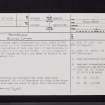Houndslow
Findspot (Period Unassigned), Scabbard (Bronze)(Period Unassigned)
Site Name Houndslow
Classification Findspot (Period Unassigned), Scabbard (Bronze)(Period Unassigned)
Alternative Name(s) Hounslow
Canmore ID 57307
Site Number NT64NW 11
NGR NT 629 472
NGR Description NT c. 629 472
Datum OSGB36 - NGR
Permalink http://canmore.org.uk/site/57307
- Council Scottish Borders, The
- Parish Westruther
- Former Region Borders
- Former District Berwickshire
- Former County Berwickshire
In 1867, the bronze tip of an Early Iron Age sword scabbard was found in a ditch near Houndslow. It is now held in the National Museum of Scotland under the accession number FA 80, after being gifted to the museum as part of the collection of a local antiquarian, Lady John Scott.
The chape is made of cast bronze and measures approximately 50mm by 60mm. The condition is reported as being very good, with no wear visible. Studies of Iron Age artefacts have allowed a classification system to be built up, as changes in design over time can be seen. The scabbard-tip found at Houndslow has been identified as a 'Bugthorpe' type, which is found in southern Scotland, north-east England and Ireland. Influenced by continental metalwork, the type of chape found here also shows the individual skills of the local metalworkers through its design and decoration.
This type of chape has been dated to the 1st century BC. It was found without an associated sword and it is likely that the rest of the scabbard was made out of an organic material such as leather so will not have survived. The lack of wear may indicate that the item was deposited as an offering to gods or ancestors, or simply that the item was lost before it was used.
Text prepared by RCAHMS as part of the Accessing Scotland's Past project
NT64NW 11 629 472.
A cast bronze chape (sword-scabbard tip), found in 1867 in a drain (3) N of Houndslow (NT 629 472) and formerly in the collection of Lady John Scott of Spottiswoode, is now in theNational Museum Antiquities of Scotland (NMAS Accession no: FA 80). It is of Piggott's Group III (Bugthorpe Type), and dated by Ritchie to the 1st century BC.
S Piggott 1950; Proc Soc Antiq Scot 1921 (Donations); J N G Ritchie and A Ritchie 1972; NMAS Contiuation Catalogue.
No information was obtained from local enquiries. Approximately 350m N of Houndslow is a deep ditch which could have been the drain in which this item was found.
Visited by OS(JD) 2 May 1955.
Sbc Note
Visibility: Not applicable. Site of an unprovenanced find.
Information from Scottish Borders Council










